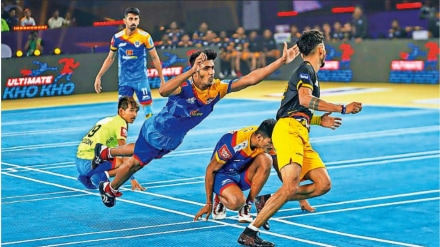Ultimate Kho Kho, the premier league for one of India’s oldest and much-loved sports, is gearing up for season three with a new anthem that blends indigenous energy with modern elan even though the season is slated to begin at the end of this month.
But can the relatively new property do what the Pro Kabaddi League (PKL) did? Organisers are upbeat. Says promoter Amit Burman, also chairman of FMCG firm Dabur, “Ultimate Kho Kho (UKK) is a movement celebrating India’s kho kho legacy through a modern lens. As we edge closer to season three, our focus is on elevating the league’s stature and broadening its reach.”
Burman has pledged `200 crore towards the league already, which has over the past couple of years seen interest from other corporate firms such as Adani and GMR Group.
The numbers from the first two seasons are promising. In its first two seasons, the league logged a cumulative audience reach of 164 million, with 41 million domestic and an impressive 64 million global viewers across TV and OTT. Broadcast by Sony Pictures Networks India (SPNI), UKK also recorded a surprise 40% share of women viewers, unusual for a new sports property.
Noting that early signs are positive, Santosh N, managing partner, D and P Advisory says, “There’s a lot that UKK can learn from the journey of the Pro Kabaddi League (PKL), which has shown how a traditional Indian sport can be completely transformed with the right mix of modern presentation, fast-paced gameplay and strong storytelling. What really worked for PKL was how it turned kabaddi into a spectacle through professional production, simplified formats, and smart use of technology.”
PKL has been around for a decade, during which it has built emotional depth, allowing fans to feel a sense of ownership over their favourite teams.
Recipe for success
For UKK to grow and thrive, experts agree that advertiser support will be key. The first couple of seasons has seen the UKK achieve a net value of over `130 crore, as per reports.
Indian Oil coming on as the ‘powered by’ sponsor last season signals serious commercial intent, points out Neelesh Pednekar, co-founder and head of digital media at Social Pill. “The combination of fast-paced play, franchise formats and smart presentation makes it attractive. For advertisers, that means a growing, engaged audience beyond just major metros. Brands bring three critical inputs in funding, credibility and amplification. With season three beginning this month, the league could be entering its moment of commercial inflection,” notes Pednekar.
Live broadcast of sports is a gamechanger, enabling better reach and driving greater advertiser interest, observes KV Sridhar, global chief creative officer, Hypercollective and Nihilent. It was live broadcasting that gave cricket its commercial success, completely transforming the way it has been consumed since the 1980s. “With live broadcasting, there is greater monetisation opportunity. We’re seeing how women’s cricket has also transformed in the last few years,” he says.
While the forecast for the UKK is largely positive, Siddharth Devnani, co-founder & COO, SoCheers says that its success will come with a larger media push and greater momentum. “We need active participation from top sports personalities, corporate houses, government bodies and even political figures,” he says.
The success of kabaddi and the heartening response so far to the UKK is a sign of a nation that is becoming more comfortable with itself and its traditions, adds Sridhar. “No more are these sports looked down upon as compared with others such as football, cricket or tennis,” he says. With many Indians having played the sport in their childhoods, it could travel well beyond top tier cities and metros.
